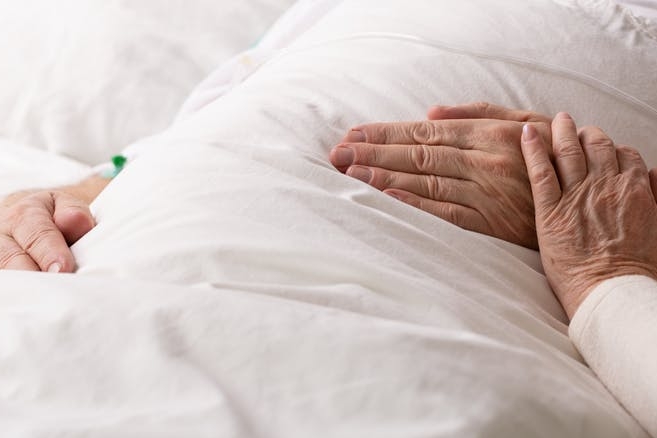Beautiful Voice editor’s note: This article was originally published one year ago – May 28, 2020 – prior to the availability of vaccines. The author, Barbara Pesut, PhD, is a nursing professor in British Columbia, Canada. A retrospective review of the article provides the reader with insights about dying alone in long-term care facilities: “These incidents have not only devastated family members but also disturbed many people with the sense that something has gone wrong with how our society cares for aging or vulnerable people and responds to illness and dying.” The article focuses on a culture of care which is not an issue just for Canadians. Nor is it an issue just for health professionals and residential care providers. It is for the whole of society.
Author: Barbara Pesut, PhD, Professor, School of Nursing; Canada Research Chair in Health, Ethics, and Diversity, University of British Columbia
May 28, 2020
One of the most heartbreaking aspects of the COVID-19 physical distancing has been accounts of people dying alone in hospital or in long-term care facilities.
These incidents have not only devastated family members but also disturbed many people with the sense that something has gone wrong with how our society cares for aging or vulnerable people and responds to illness and dying.
On May 19, the Canadian Hospice Palliative Care Association (CHPCA) launched a campaign called “Saying Goodbye” that calls on health authorities to “implement a more compassionate approach to end-of-life visitations across Canada during the COVID-19 pandemic.” The CHPCA says that “while certain provinces have taken steps to relax visitation protocols for end-of-life situations, many hospitals and long-term care homes still do not allow family access, even with personal protective equipment (PPE).”
Dying in long-term care
In my province of British Columbia, the B.C. Centre for Disease Control guidelines suggest that there is indeed room for “essential visits” in long-term care facilities.
These are described as including but not being limited to “visits for compassionate care (end of life and critical illness), visits considered paramount to resident care and well-being, such as assistance with feeding or mobility ….”
But there is a great deal of room for interpretation of what constitutes an essential visit.
One might argue that those in long-term care are not imminently dying and so perhaps the right of family to be present does not outweigh the risks of COVID-19.
Firstly, however, families with people in long-term care will tell you that their visits are essential. The COVID-19 crisis has revealed many of the fault lines in our long-term care system.
Those in residential or long-term care can be at risk and it is often the vigilance of family members that ensure that these vulnerable persons receive adequate care. A family member who visits regularly is a powerful surveillance system.
Palliative care
Secondly, what health-care practitioners call an “end-of-life situation” exists, in fact, on a continuum.
The Office of the Seniors Advocate British Columbia notes that the average length of stay for residents in long-term care is 871 days — less than two-and-a-half years. That means that if following best practices, all people residing in long-term care should receive a palliative approach to care.
The World Health Organization defines hospice and palliative care as “… an approach that improves the quality of life of patients and their families facing the problems associated with life-threatening illness.” It seeks to prevent and relieve “suffering by means of early identification and impeccable assessment and treatment of pain and other problems, physical, psychosocial and spiritual.”
Of note in this definition highlighting “patients and their families” is that palliative care seeks to address people holistically as individuals in relationships.
Although most Canadians wish to die at home, circumstances often lead to an institutional death. Long-term care has increasingly become a site for palliative care. Wishes for care are obtained upon admission and the supportive principles of palliative care are applied to ensure that people in care enjoy the highest quality of life possible for the limited time they have left.
But the fact that many people still need institutional care at end of life has proven exceedingly challenging in the context of the physical distancing requirements of COVID-19.

(THE CANADIAN PRESS/Graham Hughes)
Community vs. individual
In times of pandemic, ethical decision-making tends to emphasize the good of the community over the good of the individual.
But paradoxically, the good of individuals is also harmed when they are prevented from honouring their community and family ties. How we approach these difficult decisions reveals a lot about what we see to be most valuable in life and how we perceive the good.
From a public health ethics perspective, the harm principle means that…
But if impinging on the rights of an individual is actually a matter of harm — insofar as it violates ancient social and ethical values about care for elders or the dying, and thereby hurts the dying and their loved ones — we need to think differently.
Deliberating such challenging ethical decisions, and having the adequate resources to respond to them, can rarely be accommodated ad hoc. Rather, it requires careful planning at a systems and institutional level and significant resources, space, education, screening and infection control measures.
At a higher level, it also means our research investments and policy deliberations about COVID-19 must not abandon questions related to what it means to die with the disease or in the context of the pandemic.
Harm-reduction approach
Those we love are an integral part of our dying journey. So much so that a recent court case in the United Kingdom concluded that patients have a fundamental right to be with their family at the time of death.
In a context where patients are receiving a palliative approach to care, we need to start from the assumption that living and dying alone is so potentially harmful that we need to balance harms using a harm-reduction approach.
We have come to know of the value of harm reduction primarily from people who are vulnerable because of addictions.
We provide treatment that seeks to attenuate harm, even if there is some risk involved. Perhaps we need to be applying this same strategy to keeping dying persons and family together in palliative care.
Perhaps particularly in the context of a limited life span, for individuals in care, the harm of separation must be considered alongside the harm of infection. Respecting the rights of those who are dying would then mean we need to allow them and their loved ones to take some risks. This means, of course, ensuring that facilities are adequately resourced not only with the equipment they need to protect staff and visitors but also with personnel who can collaborate across care teams.
Until a vaccine is found, COVID-19 is here to stay — but these precious lives are not. Giving people permission to be together at the end of their lives will take some ingenuity and money. But it’s the right thing to do.![]()
This article is republished from The Conversation under a Creative Commons license. Read the original article.
Author
![]() Barbara Pesut, PhD, Professor, School of Nursing; Canada Research Chair in Health, Ethics, and Diversity, University of British Columbia
Barbara Pesut, PhD, Professor, School of Nursing; Canada Research Chair in Health, Ethics, and Diversity, University of British Columbia
Posted by: Susan Troyer



Leave A Comment